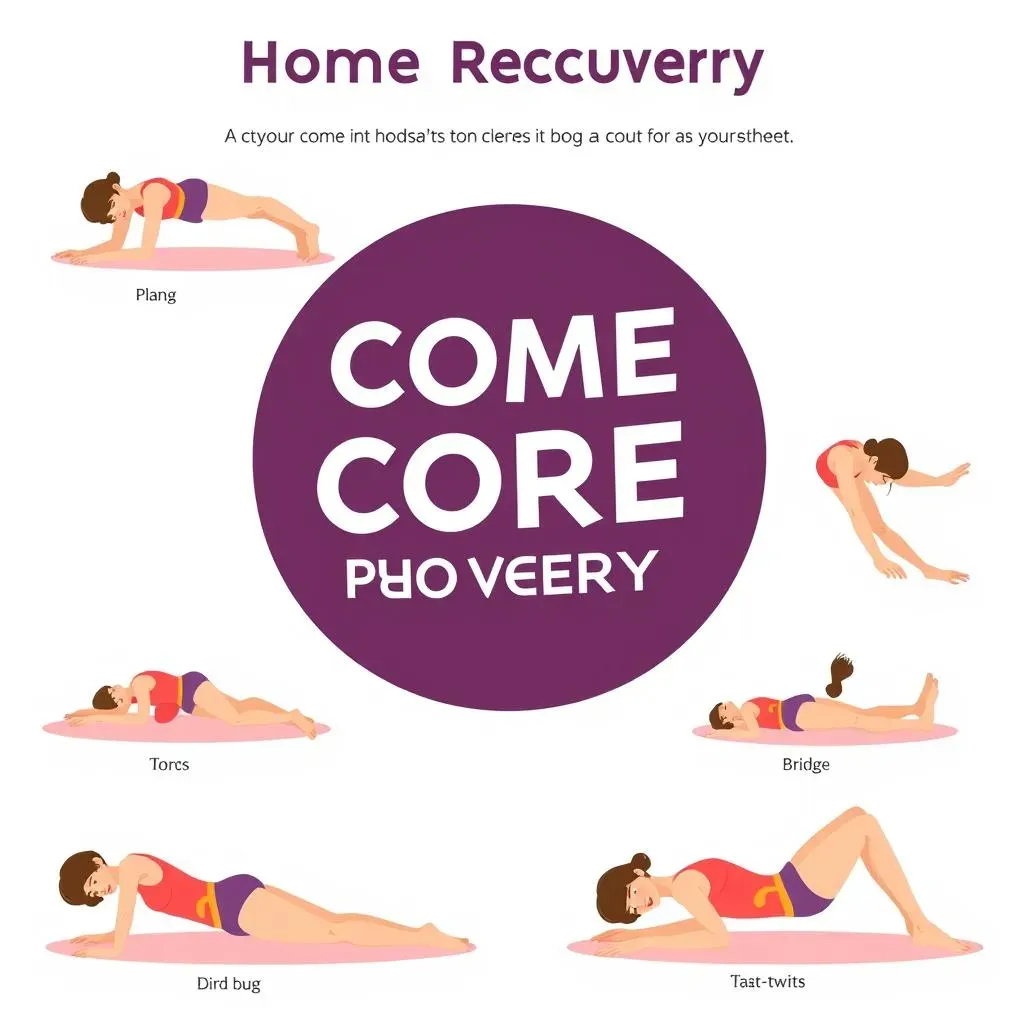Table of Contents
Feeling stiff, sore, or just plain beat after a tough workout or a long day? You’re not alone. Many of us overlook the importance of a strong core for overall recovery, but it's the secret weapon to feeling better and moving with ease. This article is your guide to understanding how simple core workouts at home for recovery can make a massive difference. We'll break down why a strong core is essential, not just for those six-pack abs, but for your everyday well-being and healing process. I'll walk you through some of the most effective exercises you can do right in your living room, no fancy gym equipment needed. We'll discuss how to fit these into your recovery routine, and I'll point out some common pitfalls to avoid. So, if you are ready to unlock the power of your core, let’s get started and discover how to make core workouts at home for recovery a game changer.
Why Core Strength Matters for Recovery

Why Core Strength Matters for Recovery
The Core's Role Beyond Abs
Okay, so when we talk about core strength, most people immediately picture those washboard abs, right? But here’s the thing: your core is so much more than just your six-pack. It's like the sturdy trunk of a tree, supporting everything else. Think of it as the center of your body's power, a complex network of muscles that includes your pelvic floor, transverse abdominis, obliques, and even the muscles around your spine. These muscles work together to stabilize your spine, help you move efficiently, and protect you from injuries. When your core is strong, it's like having a built-in brace, allowing you to move with more control and less strain. So, when it comes to recovery, it’s not just about resting; it’s also about building that solid foundation.
A weak core can manifest in many ways. For example, ever feel that nagging lower back pain after a simple task? That’s often your core crying out for help. It’s not just about lifting heavy weights; it's about having the strength to sit at your desk without slouching or walk without wobbling. A strong core leads to better posture, balance, and overall stability. And when you're recovering from an injury or intense workout, that stability is crucial for preventing further issues. It helps distribute force evenly, taking pressure off vulnerable areas. It also improves your proprioception – your body’s awareness of its position in space. So, strengthening your core isn't just about aesthetics; it's about building a resilient body that can handle whatever life throws at it.
The Core and Injury Prevention
Now, let's talk about why this is so crucial for recovery. A robust core acts like a natural shield, protecting your spine and joints during movement. Imagine lifting a heavy box. With a weak core, your back might take the brunt of the force, leading to strain or injury. But with a strong core, those muscles engage, helping to distribute the load and keep your spine in a safe position. This is why core work is not just about recovery, but also about preventing future setbacks. For me, I had a knee injury a while back. I used to think that just resting was the answer. But, it was the core exercises that helped me to walk and move again.
Think of your core as the unsung hero of your recovery. It's the foundation for every movement you make, from walking to reaching for a cup of coffee. A strong core ensures that you are moving with the correct alignment, reducing unnecessary stress on your joints. When you're recovering from something, your body is already under a little stress. So, this extra support is very important. And it’s not just about physical recovery either. A strong core has been linked to improved mental well-being, and even help with things like digestion and breathing. It's a holistic approach to health, where everything works together to keep you strong and stable.
Benefit | How it Helps Recovery |
|---|---|
Improved Stability | Reduces stress on joints and spine during movement. |
Better Posture | Minimizes strain and pain, leading to more efficient movement. |
Injury Prevention | Provides a natural brace to protect vulnerable areas. |
Enhanced Proprioception | Improves body awareness, reducing the risk of accidents. |
Overall Well-being | Contributes to both physical and mental health. |
Effective Core Exercises for Home Recovery

Effective Core Exercises for Home Recovery
Bodyweight Basics for Core Strength
Alright, let's get into the fun part: the exercises! You don't need a gym or fancy equipment to build a strong core; your own bodyweight is all you need. We're going to start with some fundamental moves that are perfect for recovery because they're gentle yet effective. First up, the plank. It's a classic for a reason. This isn't about holding it for ages, especially when you are recovering. It's about maintaining proper form, engaging your core, and feeling those muscles work. Think of it like a straight line from your head to your heels, with your belly button pulled in towards your spine. Start with 20-30 seconds and gradually increase the time as you get stronger. Another great move is the bird dog. It's not just a funny name; it's a fantastic exercise for core stability and balance. Think slow and controlled movements, focusing on keeping your back straight and your core engaged.
Next, we have bridges. Bridges are great for activating your glutes and lower back, which are crucial parts of your core. Lie on your back, knees bent, and lift your hips off the floor, squeezing your glutes at the top. It's like you're creating a straight line from your knees to your shoulders. Another exercise that's often overlooked is the dead bug. This may look simple, but it's sneaky challenging and great for core control. Remember, these exercises are not about speed; they're about control and proper form. You want to feel the muscles working, and if you feel any pain, stop and adjust. Consistency is key here. Doing a little bit each day is way more effective than trying to do too much all at once, especially during recovery. I remember when I first started, I was super impatient and just wanted to do as many reps as possible. It was a mistake and I learned that slow and steady wins the race.
Adding Gentle Movement for Recovery
Now, let's add some gentle movement to our core routine. These exercises are fantastic for improving circulation, easing stiffness, and promoting healing. Think of these as a light massage for your core. First, cat-cow stretches. These are not just for yoga; they’re fantastic for mobilizing your spine and gently engaging your core. Alternate between arching your back like a cat and dropping your belly towards the floor like a cow, moving slowly and with your breath. It’s like a gentle wave moving through your body. Then we have side-to-side torso twists. These are great for your obliques, which are essential for core stability. Sit with your legs crossed and gently twist your torso from side to side, keeping your back straight. It's a simple move, but it can make a big difference in how your core feels.
Lastly, let's talk about pelvic tilts. These are small, subtle movements that can have a big impact on your core. Lie on your back with your knees bent and gently rock your pelvis forward and back, engaging your lower abs. It’s like you're trying to press your lower back into the floor and then tilting your pelvis up to the ceiling. These movements might seem small, but they are powerful for improving core awareness and reducing lower back pain. These exercises will not only help you recover but will also make your body feel much better. Remember, recovery is not about pushing yourself harder; it's about listening to your body and moving with intention. I've found that these gentle movements are incredibly helpful, especially after a long day or a tough workout. They're like a reset button for my body and mind.
Exercise | How it Helps | Repetitions |
|---|---|---|
Plank | Strengthens entire core | 20-30 seconds, 3 sets |
Bird Dog | Improves balance and stability | 10-12 reps per side, 3 sets |
Bridges | Activates glutes and lower back | 12-15 reps, 3 sets |
Dead Bug | Enhances core control | 10-12 reps per side, 3 sets |
Cat-Cow | Mobilizes spine, engages core | 10-12 reps, 3 sets |
Torso Twists | Works obliques | 10-12 reps per side, 3 sets |
Pelvic Tilts | Improves lower core awareness | 10-12 reps, 3 sets |
Integrating Core Workouts Into Your Recovery Routine

Integrating Core Workouts Into Your Recovery Routine
Timing is Key: When to Focus on Core
Okay, so you're convinced that core work is important, but when do you actually fit it into your recovery routine? It's not about adding another grueling workout to your day. Instead, think of core exercises as a gentle way to help your body heal and feel better. The best time to incorporate these exercises is on your active recovery days or rest days. This means you're not pushing your body to its limits but rather encouraging blood flow and muscle recovery. For me, I often do my core exercises in the morning or after a light walk. It's a great way to wake up my body and get it ready for the day without overdoing it. Remember, it's not about how hard you push but about how consistently you show up.
Avoid doing intense core workouts right after a strenuous training session. Your muscles are already fatigued and need time to recover, not more stress. Instead, focus on gentle exercises that promote blood flow and reduce stiffness. Think of them as a gentle massage for your core. It's about finding that sweet spot where you're challenging your muscles without overworking them. When you're starting, it's often best to start slow and see how your body responds. If you feel any pain, it's a sign that you need to pull back a bit. The goal is to help your body heal, not set it back. It’s like watering a plant; you don’t dump a whole bucket of water at once, you gently nourish it over time.
Creating a Core-Focused Recovery Plan
Now, let’s talk about creating a plan. It doesn’t have to be complicated. Start with just 10-15 minutes of core exercises 3-4 times a week. Choose 2-3 exercises from the list we discussed before, and do them in a circuit. This means you move from one exercise to the next with minimal rest. For example, you could start with a 30-second plank, then do 10 reps of bird dogs on each side, followed by 12 bridges, and then a minute of cat-cow stretches. Repeat this circuit 2-3 times, and you've got yourself a solid core recovery routine. The key is to listen to your body and adjust as needed. If you're feeling great, you can increase the duration or repetitions. If you're feeling sore, take it easy and focus on proper form.
Remember, consistency is more important than intensity. It's better to do a little bit consistently than to do a lot sporadically. Think of it like brushing your teeth. You don't brush your teeth once a week for an hour; you do it every day for a few minutes. The same goes for core work. Make it a habit, and soon you'll start noticing the benefits. Also, make sure to hydrate well and nourish your body with good food. Recovery is not just about exercise; it's about taking care of your body from the inside out. I often make sure to get a good night's sleep after my core exercises; it makes a big difference in how I feel the next day. It’s like giving your body a chance to recharge and repair itself.
Action | Description | Frequency |
|---|---|---|
Core Exercises | Choose 2-3 exercises from the list. | 3-4 times per week |
Duration | 10-15 minutes per session | As needed |
Timing | Active recovery or rest days. | Avoid after intense workouts |
Intensity | Gentle movements with proper form | Listen to your body |
Hydration and Nutrition | Drink plenty of water and eat well | Daily |
Common Mistakes and How to Avoid Them in Core Recovery

Common Mistakes and How to Avoid Them in Core Recovery
Pushing Too Hard, Too Soon
Okay, let's talk about some common slip-ups people make when trying to use core work for recovery. The biggest one? Going too hard, too soon. It's like trying to run a marathon without ever having trained. You might be super motivated, but your body isn't ready for that level of intensity, especially when you're recovering. Instead of jumping into a hardcore ab workout, start with those gentle exercises we talked about. If you try to do too much too quickly, you are more likely to get an injury. When I started, I was so excited and eager to get results that I was pushing too hard and it resulted in a lot of pain. It's important to be patient and build up slowly.
Another common mistake is focusing only on your abs, neglecting the rest of your core. Remember, your core isn't just about your six-pack; it's a whole network of muscles that work together. If you only focus on crunches, you might be neglecting other essential muscles like your obliques, lower back, and pelvic floor. This can lead to muscle imbalances and increase the risk of injury. Think of it like building a house; you wouldn't just focus on the front wall and ignore the rest. You need a strong foundation all around. So, make sure your core routine is balanced and includes exercises that target different muscle groups. Also, don’t forget about your breathing. Holding your breath during core exercises can actually strain your muscles and make the exercises less effective. Focus on slow, controlled breaths, inhaling as you relax and exhaling as you engage your muscles.
Ignoring Pain and Poor Form
Ignoring pain is another big no-no. If you feel a sharp or persistent pain during any core exercise, stop immediately. It's your body telling you that something is not right. Pushing through pain can lead to more serious injuries and set back your recovery. It's like ignoring the warning light on your car; it might seem okay for a bit, but eventually, it's going to cause a bigger problem. It's far better to take a break, adjust your form, or choose a different exercise. Listen to your body; it's your best guide. Another crucial thing is to pay attention to your form. Doing core exercises with bad form is not only ineffective, but it can also be dangerous. If you are not sure how to do a particular exercise, it’s always best to get the help of a professional.
I've seen so many people rushing through exercises or not focusing on the correct form, and it never ends well. Focus on quality over quantity; it's much better to do a few reps with perfect form than a lot of reps with bad form. It's like practicing a musical instrument; you wouldn’t just play random notes; you would practice slowly and carefully to get it right. Also, remember that recovery is a process, not a destination. There will be days when you feel great, and days when you feel sore. It’s about being patient and consistent, rather than expecting immediate results. Don't get discouraged if you don't see progress right away, just keep going and you will get there eventually. And finally, make sure to celebrate small wins. If you are able to do one more rep, or hold a plank for a few seconds longer, that is something to be happy about. It is all part of the journey.
Mistake | How to Avoid It |
|---|---|
Pushing too hard, too soon | Start with gentle exercises and gradually increase intensity. |
Focusing only on abs | Include exercises that target all core muscles. |
Ignoring pain | Stop immediately if you feel sharp or persistent pain. |
Poor form | Focus on quality over quantity; get help if needed. |
Holding your breath | Breathe slowly and controlled during exercises. |
